Costa Rica, a country famous for its ecotourism appeal, is not only known for its beautiful flora and fauna, although they are of incomparable beauty. This country is also the volcanic jewel of Central America. The territory of Costa Rica is part of the majestic Pacific Ring of Fire, possessing more than 200 identified volcanic formations, dating back more than 65 million years ago. However, today only a little more than 100 formations that show signs of volcanic activity. It should be noted that not all these formations are volcanoes; there are also pyroclastic cones, craters, boilers, volcanic relicts, lava domes, and shields, just to mention a few varieties. Most of Costa Rica’s volcanoes are in the northern part of the country and in the Central Highlands.
The land of fire, Costa Rica, is crossed by three volcanic mountain ranges: the Guanacaste Range integrated by volcanoes of great importance such as the Arenal or the Rincón de la Vieja; the Central Volcanic Range integrated by the wonderful volcanoes Poás, Turrialba and Barva; and finally, the Range or Cordillera de Tilarán with the Arenal and El Chato volcanoes.
Unique, imposing and of enormous importance
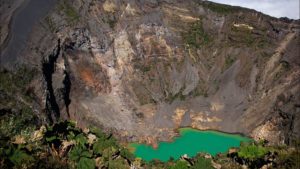
These volcanoes are considered the greatest tourist attraction in Costa Rica as they captivate the attention not only of the hundreds of tourists who come to the country to meet them but also of scientists from all over the world. They are also a key part of the spectacular natural diversity of Costa Rica because they play a very important role in how the lush landscapes of the region have developed. As a result of the multiple eruptions of thousands of years, the land of Costa Rica is very fertile as well as being very rich in many minerals. This fertility on its part not only contributes to the green vegetation but also sustains an incomparable amount of birds and wildlife species and home to numerous tropical and exotic plants and trees.
In addition to its fertility and natural beauty, the volcanoes of Costa Rica are also fabulous recreational parks as they can do many walks, rafting in crystal clear waters, sports fishing, surfing, paddling, swimming, kayaking, horseback riding, camping, mountain biking in addition to knowing and exploring the region.
Although volcanoes in Costa Rica are known as “young” as they have been formed in the last 2 million years, each has characteristics that make them incomparable, for example, the Irazú Volcano is known for its amazing blue lake greenish located in one of its craters, while in one of the craters of the Poás Volcano there is a boiling lake of acid.
The 5 tico volcanoes that you should know
The Poas Volcano
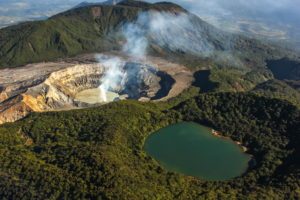
The Poás volcano has three craters and one of them measures 1.5 kilometers which makes it one of the largest volcanoes in the world. The landscape in the Volcano National Park is very arid around the crater and very leafy in the rest of the more than 50,000 hectares that the park has. The water of the volcano is a very characteristic turquoise blue and that is due to a large amount of sulfuric acid in the water, a very beautiful phenomenon of nature.
Irazú volcano
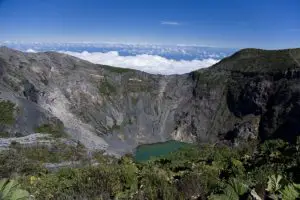
The Irazú volcano is one of the most popular among tourists since it has five craters where one of them has a lake with a spectacular emerald green color that contrasts with the dark stone of the volcano. Although it is often covered by clouds lucky tourists whose visits coincide with a clear day will appreciate the beauty of the place.
Arenal volcano
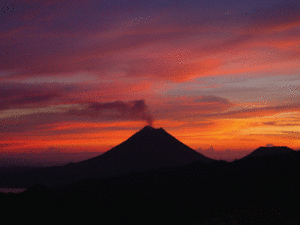
El Arenal is perhaps the most famous of all the volcanoes in Costa Rica. This is because until recently it was one of the most active in the country, emitting hot gases and steam clouds regularly. This was stopped in December 2010. Known for having a “perfect” volcanic cone, the Arenal is, in fact, a beautiful place to see from a distance since it is perched on the lowlands and beautiful landscapes of the Arenal National Park.
El Rincón de la Vieja volcano
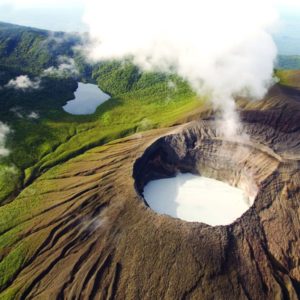
The Rincón de la Vieja is located in Guanacaste, 25 kilometers northeast of the city of Liberia. Among its most defined craters are the Von Seebach, the Active Crater, the Rincón de la Vieja and the Santa Maria, with varying heights. The Active Crater has a constant and intense fumarolic activity. Rincón de la Vieja National Park covers 14,000 hectares, and is one of the most spectacular protected areas in the country for its waterfalls, tropical forest, pastures, active fumaroles, hot springs and rich wildlife, as varied as its landscapes.
Turrialba volcano
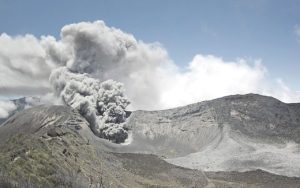
The Turrialba Volcano, twin of the Irazú for sharing the same base, is very similar to its “brother”. It is the second highest volcano in the country and one of the widest, has three well-defined craters, and in its skirts, there is more vegetation than in Irazú. To protect the 1577 hectares of forest that surround it, a national park was created in 1955.
